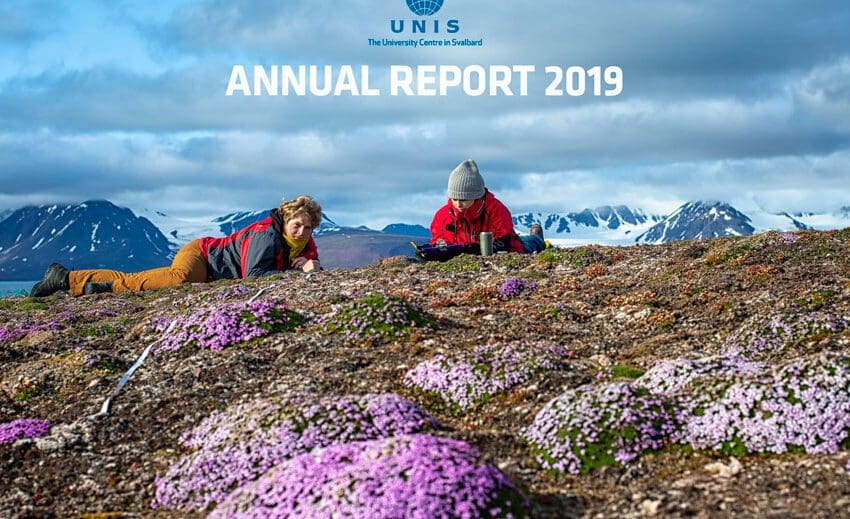UNIS Annual Report 2019

UNIS annual report 2019 frontpage. Photo: Mads Forchhammer/UNIS.
Top image: AB-201/AB-204 students count Silene flowers in Woodfjorden. Photo: Mads Forchhammer/UNIS.
27 May 2020
Number of students
In 2019, 743 students spent shorter or longer periods at UNIS, including both course students and guest master’s students. Of the students in 2019, 50% came from programmes of study at Norwegian universities, the rest from international universities.
In recent years, UNIS has had a reasonably balanced gender distribution, with a slight predominance of women. In 2019 57% of the students were women. UiT – The Arctic University of Norway is the Norwegian university that sends the most students to UNIS, closely followed by the Norwegian University of Science and Technology (NTNU).
Student production
A total of 213 student-labour years were produced at UNIS in 2019, of which 193 student-labour years were linked to credits (ECTS) from completed courses and 20 student-labour years linked to presence by guest master’s students.
Staff numbers
As of 31 December 2019, the academic staff at UNIS comprised of 13 professors, 13 associate professors, two researchers, six post docs, 17 internal PhD candidates and 40 staff with adjunct professor/associate professor attachments. The technical and administrative staff comprised 38 full-time equivalent work years. Women accounted for 49% of the technical and administrative positions, 54% of the academic positions and 57% of the students.
Research and academic initiatives
In line with UNIS’ new strategy, the institution is developing goals and organisational structures to strengthen research. In 2019, UNIS aimed at larger and more long-term projects in strategically important areas. This means a more pan-Arctic approach to research issues, while at the same time clarifying UNIS’ corporate social responsibility in Longyearbyen.
UNIS has increased its project portfolio during 2019 and received funding for several major new projects. In 2019, the Department of Arctic Biology (AB) was successful with a major research application (FACE-IT) to the EU’s Horizon 2020, along with Norwegian and international partners. The project is pan-Arctic and AB has a key role in the marine sampling in Svalbard. Furthermore, the Department of Arctic Geology (AG) and Arctic Geophysics (AGF) gained funding for a Centre for Excellence in Education (iEarth), which also has a significant research component. AG is leading a project funded by the Research Council of Norway about microorganisms in the ice (BIOICE), and a project about methane under the permafrost (CLIMAGAS).
In addition to the new projects, the Nansen Legacy involves research within marine biology and oceanography and is still the largest project at UNIS. The Birkeland Centre for Space Science, which is a Norwegian Centre of Excellence, still has significant activity, although it now has a reduced budget compared with previous years.
SAMCoT – Sustainable Arctic Marine and Coastal Technology – was a Centre for Research-based Innovation led by NTNU, which had 23 partners and was discontinued in 2019. The Department of Arctic Technology (AT) and the Technical and Logistics Unit at UNIS contributed to SAMCoT becoming a centre that was an international leader in the development of robust technologies that are used by the industry operating in the Arctic.
Svalbard Integrated Arctic Earth Observing System (SIOS) is organised as a subsidiary of UNIS. Its main task is to coordinate and develop further an international research infrastructure to research the regional effects of climate change.
In 2019, UNIS had a total of 150 large and small projects, which constituted a turnover from external activities of NOK 42,3 million.
[ct_button link=”https://www.unis.no/wp-content/uploads/2020/06/UNIS_Annual_Report_2019.pdf” solid=”1″ has_arrow=”0″]Download the annual report here (PDF)[/ct_button]